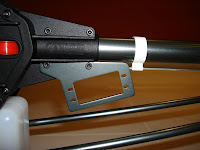The time has come... My current stock trex XL is reaching its flying capability soon unless i upgrade it. It is one of the better mini helis to learn on, i have progressed from heli noob to hovering, forward flight, figure 8, nose-in, stall-turns and recently loops on it. The size is fairly easy to carry around yet much more stable than those micro helis like honeybee, dragonflys which i have seen flyers crashing and spending more than 1/2 of the time at the field doing repairs.
But the trex gets affected by the wind and cant fly far before its hard to judge orientation. Flight time is awefully short with just 2 packs of lipos. A bigger heli with more flight time will be a better platform to progress on. 50size helis seems to be the right size. The choice is then electric or nitro.
I would prefer electric given my EE background and the convenience it offers at the field. Besides plug-n-play, quiet, lipos and brushless motors are more efficient than glow engines in converting energy to power. The power to weight ratio for E-heli surely overwhelms nitro ones. Electric power has arrived and is definitely the way to go in the future. However for now have to look into one very important factor. The moolah, $.
Just compare the energy source alone, for a hard 6 mins 3D flight will need a 10S1p which cost USD400 or SGD600plus. Will need 3-4 packs to fly comfortably long and be satisfied. Each pack properly balanced, charged and used within specs suppose to last up to 200 flights. Can lipos really last that long given the abuse we throw at them?
So far i had 3 packs bloated and 2 packs cant sustain high discharge well even far before they reach their 100th cycles. Not forgetting i have seen bad crashes that totally destroyed lipo packs. Then you have to consider the ESC, motor and higher end chargers which are not cheap. Being electronics, they can get destroyed easily with improper care. And also the numerous hours spent charging the lipos.
Comparing apples to apples, a OS50SX-hyper on 1 tank of 20% nitro can go ard 8mins, each gallon costing S$40 can last 10 tanks so each flight is about S$4. You simply pay as you fly while lipos , you pay in advance but without the insurance of it lasting you 200 flights. The downside is the oil,smoke and loud noise. Some flyers love them though so its subjective.
Glow nitro engines have been around for the last 30-40 years ,its old technology but right now its the most cost effective. New and better lipos are coming out each day and the prices are dropping due to competition from the increasing numbers of manufacturers. It will be soon i hope when the it will be affordable for the majority to fly large electrics.
I did my sums, raptor 50 titan it is..

 Next up was the main rotor assembly. Slowly worked from the swash up. The kamasa head assembles much as the stock one accept for the metal blade grips. The metal blade grip had to be heated in the oven to install the radial bearings for a tight fit.
Next up was the main rotor assembly. Slowly worked from the swash up. The kamasa head assembles much as the stock one accept for the metal blade grips. The metal blade grip had to be heated in the oven to install the radial bearings for a tight fit.

 Red dampeners and green ultra light paddles used instead of stock ones.
Red dampeners and green ultra light paddles used instead of stock ones. Kasama tail feels solid and no slop.
Kasama tail feels solid and no slop.

 Hands were starting to ache after all that screwing. lol. The mechanics part is done. Up next will be the electronics setup...
Hands were starting to ache after all that screwing. lol. The mechanics part is done. Up next will be the electronics setup...
























